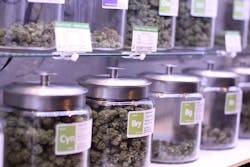What you'll learn:
- Current marijuana laws and legality
- Marijuana use impact on driver safety
- Testing challenges for marijuana impairment
- Challenges in creating a government policy
In 2012, the state of Colorado passed a ballot initiative and became the first in the United States to legalize recreational use of marijuana for adults. Colorado was shortly followed by the states of Washington, Oregon, and California. Today, the recreational use of marijuana is legal in 18 states and the District of Columbia, and there are only 12 states that prohibit marijuana use for either recreational or medicinal purposes. However, marijuana remains illegal on the federal level.
As a policy, legalizing marijuana is extremely popular with voters. According to Pew Research, 66 percent of voters support adult-use legalization and 91 percent support medical use legalization. There are many positives to legalizing marijuana, such as decriminalization, new tax revenue, additional jobs, and more regulation for safer drug use. However, there are also many cons, such as increased access for susceptible populations, mental health issues, and the potential danger for an increase in impaired driving leading to vehicle crashes.
State-level data for road safety show a steady increase in vehicle crashes involving impaired drivers under the influence of cannabis in states where the drug has been legalized. According to the AAA Foundation for Traffic Safety, 21.4 percent of Washington drivers in fatal crashes in 2017 were THC positive. This number is a significant increase from only 8.6 percent in 2008. While these statistics are significant, the numbers are difficult to interpret due to difficulties with real-time testing for drivers under the influence.
There are currently two main methods to conduct drug testing for marijuana users. Most marijuana drug testing is done by urine testing, which looks for metabolites created when the body breaks down THC. This method does not actually identify the presence of THC itself in the body, which means it does not account for “active THC” and cannot determine whether the person is impaired in real-time. Other testing methods, such as a blood or saliva test, identify “active THC.” However, while these tests provide results based on whether a person has used drugs in the past couple of hours, it still does not provide information about active impairment to determine if a person is safe to operate a motor vehicle.
A report published in December 2020 in the Journal of Safety Research found that 4 percent of Americans reported driving high, according to data from the 2016-2018 National Surveys on Drug Use and Health. Comparatively, 8.5 percent of Americans reported driving drunk. The difference is that, unlike drunk driving, police officers do not have the tools to identify and remove high drivers from the road. There is no “breathalyzer” for marijuana use.
To combat impaired driving, there are some private companies, such as Hound Labs, attempting to develop a cannabis breathalyzer. In the meantime, states with legalized marijuana use have developed their own plans to combat drugged driving. In California, the legislature has set up the Impaired Driving Task Force, and in New York, police officers are participating in drug recognition training while the state commissions a study into testing technology. Other states, such as Colorado, have set legal limits for THC levels in blood, which operates similarly to a blood alcohol test.
Unfortunately, the federal illegality of marijuana use means that there is little motivation for the federal government to dedicate resources to conduct studies on drug intoxication for road safety. U.S. House Representatives Debbie Lesko (R-Ariz) and Kelly Armstrong (R-N.D.). have both introduced legislation related to drug driving, but neither piece of legislation has gained any traction and there is no clear path forward.
As the wave of marijuana legalization continues across the United States, it is imperative that the government finds a solution to regulating impaired driving to ensure the roads stay safe. The increase of crashes involving drugged drivers is dangerous and the increase in collisions comes at a large cost for consumers. Proper testing and implementation of programs for officers to identify marijuana impaired drivers is essential to keep the roads safe if marijuana is going to continue to be safely legalized.


